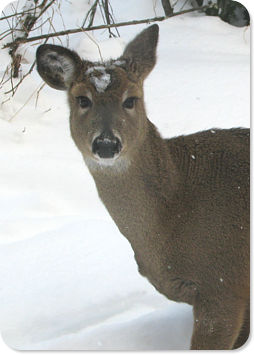 Slow down to reduce collisions with deer.(Published in the Winnipeg Free Press, Dec. 3, 2000) White-tailed deer were in the news recently with a warning from Manitoba Public Insurance Corporation (MPIC). This is the worst time of year for deer/vehicle collisions. I couldn't help thinking that, since it's the middle of hunting season, too, perhaps we really ought to be warning the deer about people! Wildlife/vehicle collisions are serious stuff, though, resulting in serious economic loss and human injury. World-wide, wherever there are roads through wildlife habitat, animals get hit. In Europe there are about 1/2 million animal/vehicle collisions a year. In the US, recent estimates put the number of deer/vehicle collisions at 720,000 annually, up from about 200,000 in 1980. In Australia, kangaroos are the problem, but I couldn't get any numbers. For Manitoba, Brian Smiley, with MPIC Media Relations gave me these details. In 1999 there were 12,700 wildlife/vehicle collisions reported which resulted in $14.8 million in claims. The number of collisions with large animals, assumed to be mostly white-tailed deer, was 7905. The available statistics aren't broken down by species of wildlife, so it isn't known how many moose, elk or other species are involved, but the best guess is that at least 90% of collisions involve deer. Deer/vehicle collisions have increased by 30% since 1997. Deer populations are thought to have increased over this time, with a series of mild winters. November was the worst single month for deer collisions in Manitoba in 1999, with 1365 collisions (17% of the yearly total) occurring then. The period of October to December accounted for 38% of the yearly total. So why are deer getting hit by cars so often at this time of year? There are a number of factors. The first is that deer are crepuscular by nature; that is, they tend to be most active around dawn and dusk. Shortening day lengths at this time of year means dawn and dusk coincide with a notable feature of human behaviour: rush hour! In both urban and rural settings, people are driving to and from work largely in the dark. Deer are also moving from areas that they use in the summer to more protected, wooded areas to spend the winter. And the mating season for deer, the rut, is centered around the latter part of November. This further increases the amount of traveling deer are doing and can be a source of distraction, as you might imagine. So, it's not surprising that the combination of these factors results in the highest rate of collisions. Later in winter the problem is lessened because the deer don't move around much; deeper snow and the need to conserve energy restrict their mobility. Bill Koonz, with Manitoba Conservation, used to deal with deer collisions within Winnipeg and offers further insight. In October the deer hit most often were fawns, inexperienced animals dashing into traffic, perhaps following their mothers. In November, yearling bucks predominated in the road kill. These juvenile males are being aggressively displaced by the adult bucks during the rut. And, to put things into perspective from the deer's point of view, he figures that about 25% of the total autumn deer population in the city were being killed in traffic each year! What can people do to help prevent collisions? Well, on the government scale of things, measures to consider in high collision areas include fences, over or underpasses, reflectors or other warning systems, and vegetation management to improve visibility and discourage deer from foraging along roads. In Manitoba, roadside reflectors, intended to alert deer to oncoming traffic, have been used along Hwy 59 near Bird's Hill Park, south of Brandon along Hwy 10 and in Winnipeg near Assiniboine forest. And throughout the province "deer-crossing" signs are placed wherever roads intersect with prime deer habitat and known crossing areas. On a personal level, some put faith in ultrasonic whistles on their vehicles, but there's no data to suggest these really work. However, the number one means of improving road safety for wildlife is also the number one means of improving road safety in general: SLOW DOWN! Reduced speeds, increased vigilance around dawn and dusk, and taking deer-crossing signs seriously could make the roads safer for wildlife and for us all. Thanks for reading! Got to the: < Previous Column | What's Outdoors Front Page | Next Column >
|
||
|
For more on this topic, here's some articles in NatureNorth.com: Makin' Tracks | Tracks in the Classroom | Tracks in the Snow |
||
| You can help NatureNorth produce more great articles with a secure donation through PayPal. Our Google Adsense ads pay our server costs, but that's about it. To learn more follow this link: Support NatureNorth. Thank-you! | |
Return to the: NatureNorth.com Front Page
Or pick a seasonal issue to visit:
